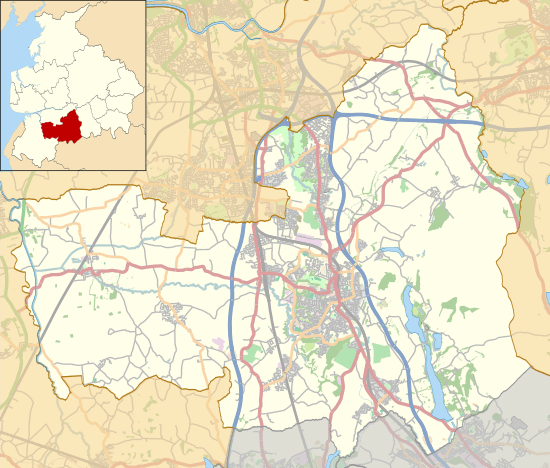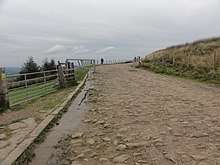Rivington Pike
Rivington Pike is a hill on Winter Hill, part of the West Pennine Moors at Rivington, Chorley in Lancashire, England. The nearest towns are Adlington and Horwich. The Pike Tower is a prominent local landmark and is located at the summit. The area is popular with hill walkers and for mountain biking.
| Rivington Pike | |
|---|---|
 | |
| Highest point | |
| Elevation | 1,191 ft (363 m) |
| Prominence | c. 50 ft |
| Coordinates | 53°37′11″N 2°32′28″W |
| Geography | |
 Rivington Pike Shown within Lancashire  Rivington Pike Shown within Chorley Borough | |
| Location | Lancashire, England |
| Parent range | West Pennine Moors |
| OS grid | SD643138 |
| Topo map | OS Landranger 109 |
Geography and geology
The pike at 1,191 feet (363 metres) high is the most westerly high point of Winter Hill in the West Pennine Moors. The high moorland is underlain with Carboniferous rocks, the Millstone Grit, sandstones and shales of the Lower Coal Measures which rise high above the Lancashire Plain to the west and Greater Manchester conurbation to the south.
From the summit it is possible to see Blackpool Tower, the Lake District mountains, the Welsh mountains and as far as the Isle of Man.[1]
History
The hill had the ancient name in Old English of hreof plus ing meaning the rough or rugged hill and pic, a pointed eminence, the earliest recorded name is Winterhold Pike in 1250 in a grant from Roger Rivington and by 1280 it was known as Roundpic within a grant by Cecily Roynton.[2] The hill was recorded as Rovyng in 1325 and Rivenpike in about 1540. Saxton records the name as Rivenpike Hill on his 1577 map.[3]
There are prehistoric sites at Noon Hill tumulus on Winter Hill, at Coblowe hillock by the Lower Rivington Reservoir and it is possible that a standing stone occupied the summit in the prehistoric period.[4]
In 1904 author, Fergusson Irvine described the Pike as "the curious hog-backed mound which crowns the summit of the hill and on which stands the Beacon, shows signs of having been at least shaped by artificial means. No doubt it is mainly a natural feature, but there are distinct traces of its having been trimmed and the approach steepened at several points".[4]
In the years 1906 to 1912 a car and motorcycle race and hill climb was held by the North-East Lancs Automobile Club and the Lancashire Motor-Cycle Club.[5]
Beacon
The prominent summit of Rivington Pike was the site of one of a series of beacons spanning England as an early warning system. The beacon system was put in place by Ranulph de Blundeville, 4th Earl of Chester around 1139, following a Scottish raid in 1138, when a small Lancashire army was defeated near Clitheroe by a much larger Scottish force. The beacon here was one of the famous examples used in Elizabethan England to warn of the approaching Spanish Armada, lit on 19 July 1588. Beacons were lit near to the tower for the coronation of King George V in 1910, to celebrate peace after the Great War in 1919 and in 1977 and 2012 to celebrate the Silver and Diamond Jubilees of Queen Elizabeth II and in 2016 for the Queen's 90th birthday.[2][6]
Tower

The Pike Tower is a Grade II* listed building on the summit. Built by John Andrews of Rivington Hall in 1733 on the site of an ancient beacon using its stone for the foundations. It was built as a hunting lodge. Square in plan with sides 16 feet (4.9 m) in length and 20 feet (6.1 m) high, it was built with a wooden roof, three windows and a door all of which are now blocked up.
The roof was slate and hidden by a parapet with pointed corners and intermediate steps, originally built with a small cellar measuring 5ft by 3ft by 5ft, a corner stone fireplace and chimney and stone floor slabs. The materials were brought in by horse and cart from Warrington; windows and glass came from Chorley.[7] The internal features and roof had gone before the rebuild.[2]
Liverpool City Council, the former owner, neglected the tower and planned to demolish it in 1967, after a public outcry and legal action the land and building was transferred to Chorley Rural District Council in 1971 who rebuilt the main external stonework of building in 1974[2] and completed further work in the 1990s.[8][2]
Events
Rivington Pike Easter Fair was held annually on Whit Saturday, until the arrival of the Manchester and Bolton Railway's extension to Preston and the opening of Blackrod railway station in 1841 which brought more visitors, after which the Fair was moved to Good Friday in 1900, by then a bank holiday weekend. It has remained popular, with large numbers attending.[9]
The Rivington Pike Fell Race is held on the Saturday before Easter Sunday since 1892. The course is 3¼ miles and has a 700-foot ascent.[10][11] Many walkers continue the Good Friday tradition of walking to the pike summit.[9]
Past campaigns
The Winter Hill mass trespass occurred here in 1896 to regain people's rights to roam. Leverhulme also supported the rights of ordinary people to access the countryside, and used his own funds to secure the rights for the inhabitants. A water bill in 1989 threatened the rights to roam in Rivington, leading to a rally held here to protect rights of access, led by the Ramblers Association.[12] A pledge was made by 3000 to protect access to the hills.[13] A further attempt by the water company to introduce a parliamentary act in 1997 was rejected after public opposition with the support of the local MP.[14]
Public access


Belmont Road (USRN 7400767) and Roynton Road (USRN: 7400820) are the two roads that provide access to the hillside, the Terraced Gardens, the Pike and Winter Hill from the direction of Chorley, Belmont and Horwich. Both are open public roads recorded on the National Street Gazetteer which are public and under the control of the Lancashire County Council with adopted status and statutory protection by way of the Highways Act 1980. Gates placed on these roads must be not be locked shut.[15][16][17] The speed advise is a maximum of 5mph. Belmont Road forks at the Pigeon Tower. The descending road has washed away. The continuation of the road to the right heads to Rivington Road and is now a dirt track across Rivington Moor. Roynton Road provides access across the lower part of the hillside and connects Rivington Lane to Sheep House Lane, via seven arch bridge.[18]
The area is popular with walkers and many other road users including horse riders, mountain bikes, and motorcycles, and may be accessed by suitable cars. Footpaths and bridleways provide access to the hillside and surrounding moorland, protected by CROW, the Countryside and Rights of Way Act 2000.[19]
Although land registry documents for the Pike do not record protection through the Liverpool Corporation Act 1902,[8] it is an area of open access land and has a right to roam.[20] The Pike hill summit was included on the map presented by Lord Leverhulme to Bolton as part of the lands donated for the creation of Lever Park and as such there is a right to 'free and uninterrupted enjoyment'.[21]
On the definitive map bridleway number 108 leads to the Pike Tower at the summit, passing Brown Hill accessible via bridleway 107 and 81 from Belmont Road. Bridleway 80 circles the base of the hill at the moorland side. There are other paths and bridleways in the area that are rights of way. The popular routes to the summit are via footpath 82, through the terraced gardens and via bridleway 98 past Higher Knoll farm.[22] In the 1990s steps were built on the hillside to prevent deterioration.
Nearby hill summits
| Name | Locality | Elevation | OS grid reference |
|---|---|---|---|
| Winter Hill † | Rivington | 1,496 feet (456 m) | SD659149 |
| Counting Hill | Smithills/Belmont | 1,421 feet (433 m) | SD671141 |
| Two Lads Hill † | Horwich | 1,276 feet (389 m) | SD655133 |
| Noon Hill † | Rivington | 1,247 feet (380 m) | SD647150 |
| Crooked Edge Hill | Horwich | 1,230 feet (375 m) | SD654134 |
| Rivington Pike | Rivington | 1,191 feet (363 m) | SD643138 |
| Adam Hill | Horwich | 1,181 feet (360 m) | SD660126 |
| White Brow | Horwich | 1,175 feet (358 m) | SD661124 |
| Whimberry Hill | Belmont | 1,115 feet (340 m) | SD686139 |
| Egg Hillock | Belmont | 1,076 feet (328 m) | SD684142 |
| Brown Hill | Rivington | 1,066 feet (325 m) | SD644135 |
| Brown Lowe | Smithills | 1,066 feet (325 m) | SD669130 |
| Burnt Edge | Horwich | 1,066 feet (325 m) | SD667125 |
| † Denotes walker's cairn or similar.[23] | |||
References
Notes
- Rivington Pike, Manchester's Countryside, archived from the original on 24 March 2012, retrieved 13 May 2011
- "Rivington". Angelfire. Retrieved 2011-01-03.
- Mills 1976, p. 126
- Fergusson Irvine 1904, p. 8
- "Races to the top of Rivington Pike". Bolton News. Retrieved 19 June 2019.
- "Rivington Pike beacon to light up the sky for Queen's 90th birthday". Chorley. Chorley Council. Retrieved 19 June 2019.
- Historic England, "Rivington Pike Tower at SD 642 137 (1072505)", National Heritage List for England, retrieved 9 June 2016
- "LAN21334, Land at Rivington Pike, Chorley". GOV UK. HM Land Registry. Retrieved 18 June 2019.
- Thousands step up for Good Friday Pike trek, The Bolton News, retrieved 13 May 2011
- Running Diary, Running Diary, retrieved 2010-06-02
- Cornthwaite grabs success at Rivington Pike Fell Race, Lancashire Telegraph, retrieved 2 June 2010
- Ashbrook, Kate. "The Rivington Pledge". campaignerkate. General secretary of the Open Spaces Society. Retrieved 6 October 2019.
- "Richard Harland, 1920 – 2013". Open Spaces Society. Open Spaces Society. Retrieved 6 October 2019.
- "MP vows to Lever Park Bill". Bolton News. 30 January 1997. Retrieved 6 July 2019.
- "National Street Gazetteer". Find My Street. findmystreet.co.uk. Retrieved 9 September 2019.
- "Types of paths in England and Wales". Rambers Association. Ramblers Association. Retrieved 4 August 2019.
- "Definitive map". Lancashire GOV UK. Lancashire County Council. Retrieved 27 June 2019.
- "National Street Gazetteer". Find My Street. Retrieved 11 October 2019.
- Moorland Fringe, Lancashire County Council, archived from the original on 30 October 2010, retrieved 3 May 2011
- "Public Access Land to the North of Bolton". Bolton Council. Bolton Council Highways Dept. Retrieved 19 June 2019.
- O'Flynn, Elaine (20 March 2014). "12 things you didn't know about Rivington Pike". Associated Press. Bolton News. Retrieved 19 October 2019.
- "Public Rights of Way". Definitive Map at Mario Maps. Lancashire County Council. Retrieved 19 June 2019.
- Fields, p. 17
Bibliography
- Codd, Daniel (2011). Paranormal Lancashire. Amberley. ISBN 978-1-4456-0658-3.CS1 maint: ref=harv (link)
- Fergusson Irvine, Wm (1904). A short History of the Township of Rivington in the County of Lancashire. Edinburgh: Ballantyne Press.CS1 maint: ref=harv (link)
- Fields, Kenneth. Five half day walks around the West Pennine Moors (2). Lancashire Country Walks.CS1 maint: ref=harv (link)
- Hampson, Thomas (1893). History of Rivington. Wigan: "Observer" Office.CS1 maint: ref=harv (link)
- Mills, David (1976). The Placenames of Lancashire. Batsford. ISBN 0-7134-5236-6.CS1 maint: ref=harv (link)
- Smith, M. D. (1989). Rivington, Lancashire. Nelson Brothers Printers Limited. ISBN 0-9508772-8-X.CS1 maint: ref=harv (link)
External links
| Wikimedia Commons has media related to Rivington Pike. |